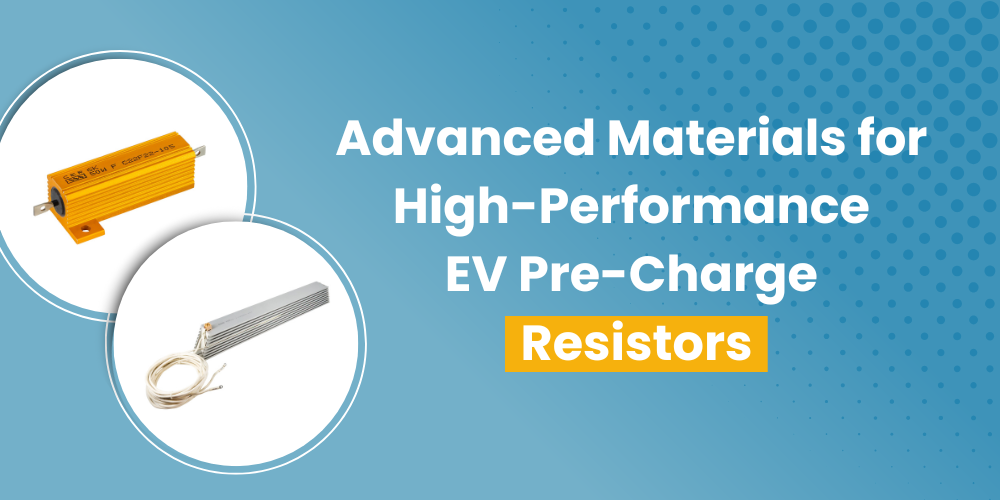
Advanced Materials for High-Performance Pre-Charge Resistors
The electric vehicle (EV) revolution is accelerating, and with it comes the increasing demand for high-performance components. One critical component often overlooked is the pre-charge resistor. This seemingly simple component plays a vital role in ensuring a smooth and safe charging process. But as EV technology advances, standard resistor materials simply aren’t enough. This blog post explores the advanced materials driving the next generation of high-performance pre-charge resistors.
The Role of Pre-Charge Resistors:
Before diving into materials, let’s briefly recap the function of a pre-charge resistor. When an EV is plugged in for charging, the battery’s voltage can be significantly different from the charging source. Directly connecting these can lead to a surge of current, potentially damaging the battery and other components. The pre-charge resistor limits this initial current, allowing the voltages to equalize before the main contactors close. This controlled pre-charge process is crucial for safety and extending battery lifespan.
Challenges for Pre-Charge Resistor Materials:
Pre-charge resistors face several demanding challenges:
- High Power Handling: They must handle significant power during the pre-charge phase.
- Pulse Load Capability: The current surge is often pulsed, requiring the material to withstand repeated high-power pulses.
- Thermal Stability: The resistor’s resistance value must remain stable despite temperature fluctuations generated during operation.
- Reliability and Longevity: EVs are expected to operate for many years, demanding high reliability from all components.
- Compactness: Space is at a premium in EVs, so components must be as small as possible.
Traditional resistor materials, like carbon film or wirewound, often fall short in meeting these combined demands, especially in high-power EV applications.
Advanced Materials Stepping Up:
To address these challenges, manufacturers are turning to advanced materials:
- Metal Film Resistors: These offer improved temperature stability and higher power handling compared to carbon film. Special alloys are used to achieve the desired resistance and temperature coefficient of resistance (TCR). These alloys can include nickel-chromium, or other specialized compositions for even greater precision and stability.
- Thick Film Resistors: Thick film technology allows for precise control of the resistance value and TCR. Specialized thick film pastes, often containing ruthenium oxide or other metal oxides, provide excellent performance characteristics. These can be tailored for specific pulse handling capabilities and thermal management.
- Ceramic Resistors: Ceramic materials, such as aluminum nitride or beryllium oxide, offer excellent thermal conductivity, helping to dissipate heat generated during the pre-charge process. These materials are often combined with resistive elements like metal oxides to create high-performance resistors.
- Cermet Resistors: Cermet (ceramic-metal) resistors combine the high-temperature strength and stability of ceramics with the conductivity of metals. This combination allows for high power handling, excellent pulse load capability, and stable resistance values over a wide temperature range. These are frequently the material of choice for demanding EV pre-charge applications.You can find more information about Cermet Resistors on our website.
The Future of Pre-Charge Resistor Materials:
Research continues to focus on developing even more advanced materials for pre-charge resistors. This includes exploring new materials with even higher power handling capabilities, improved thermal conductivity, and smaller form factors. Nanomaterials and advanced composite materials are also being investigated for their potential to revolutionize pre-charge resistor design.
Choosing the Right Material:
Selecting the appropriate material for a pre-charge resistor is crucial for ensuring optimal EV charging performance and system reliability. Factors to consider include the specific voltage and current requirements of the EV system, the expected operating temperature range, and the desired lifespan of the vehicle. Consulting with experienced resistor manufacturers, like Cermet Resistronics, is highly recommended to determine the best solution for your specific application.
Conclusion:
As EV technology continues to evolve, the demands placed on pre-charge resistors will only increase. Advanced materials are playing a critical role in meeting these demands, enabling the development of high-performance, reliable, and compact pre-charge resistors. By understanding the properties of these materials and working with experienced suppliers, EV manufacturers can ensure the safety and efficiency of their charging systems.

